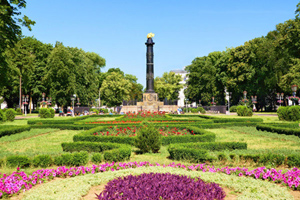|
 This monument is the most significant
sights of central Poltava. It is located in the central square
where eight radial streets converge. It was unveiled at the exact
site where a meeting between the Russian Army, headed by Tsar Peter I,
and the garrison of the Poltava Fortress, under Colonel Kelin,
took place soon after the
Battle of Poltava, and a large triumphal arch had been erected to greet the
victorious warriors. The original design of the monument was prepared by
M. Amvrosimov, a local architect. The famous Russian architect
Thomas de Thomon (of French origin) added some changes
to this first rough sketch.
This monument is the most significant
sights of central Poltava. It is located in the central square
where eight radial streets converge. It was unveiled at the exact
site where a meeting between the Russian Army, headed by Tsar Peter I,
and the garrison of the Poltava Fortress, under Colonel Kelin,
took place soon after the
Battle of Poltava, and a large triumphal arch had been erected to greet the
victorious warriors. The original design of the monument was prepared by
M. Amvrosimov, a local architect. The famous Russian architect
Thomas de Thomon (of French origin) added some changes
to this first rough sketch.
About 135,000 rubles were raised for this project from numerous
citizens throughout the country. Governor-General Count Alexey Kurakin laid the foundation
stone for the monument on June 27th 1804.
The square granite pedestal of the monument has the shape of a
fortress and is surrounded by a fence of cast-iron swords pointing
to the ground as a symbol of peace.
Eighteen guns used during the battle are mounted into its foundation.
The monumentís high cast-iron column was manufactured in Lugansk
(Eastern Ukraine). It is crowned with a
gilded bronze eagle holding arrows in his claws and fastening his eyes
towards the battlefield. Tsar Alexander I personally donated the eagle
and the bronze decorations
on the column, specially created for the monument in St. Petersburg
by P. Ekimov, a master of metal casting. The official opening ceremony
took place on June 27th 1811.
In 1802 Poltava was named the administrative center of the newly
established government. Several administrative buildings as well
as other new buildings, all designed
in the Classic style by the famous Russian architect A. Zakharov,
were built around the central square during the first decade of the
19th century. In 1840 a military school
named after Peter I was opened close to the monument. The square around the
monument was used as a drill square
until 1852 when, at the order of Tsar Nikolay I, the city created a park
around the Glory Monument. The monumentís fate has been fortunate,
as it was never damaged or destroyed during the nearly two centuries that
have passed since the opening ceremony.
In 1974 and again in 2004 it was completely renovated.
|
 History
History
 Dates and events
Dates and events
 Persons
Persons
 Poltava
Poltava
 Sights
Sights
 Photo gallery
Photo gallery
 Maps
Maps
 Virtual Museum
Virtual Museum
 Armament
Armament
 Uniforms
Uniforms
 Coins and medals
Coins and medals
 Flags
Flags
 Paintings
Paintings
 Poltava photographs
Poltava photographs
 News
News
 About us
About us
 Acknowledgments
Acknowledgments
 Main page
Main page
 Photo gallery
Photo gallery
 top
top ...back
...back  This monument is the most significant
sights of central Poltava. It is located in the central square
where eight radial streets converge. It was unveiled at the exact
site where a meeting between the Russian Army, headed by Tsar Peter I,
and the garrison of the Poltava Fortress, under Colonel Kelin,
took place soon after the
Battle of Poltava, and a large triumphal arch had been erected to greet the
victorious warriors. The original design of the monument was prepared by
M. Amvrosimov, a local architect. The famous Russian architect
Thomas de Thomon (of French origin) added some changes
to this first rough sketch.
This monument is the most significant
sights of central Poltava. It is located in the central square
where eight radial streets converge. It was unveiled at the exact
site where a meeting between the Russian Army, headed by Tsar Peter I,
and the garrison of the Poltava Fortress, under Colonel Kelin,
took place soon after the
Battle of Poltava, and a large triumphal arch had been erected to greet the
victorious warriors. The original design of the monument was prepared by
M. Amvrosimov, a local architect. The famous Russian architect
Thomas de Thomon (of French origin) added some changes
to this first rough sketch.